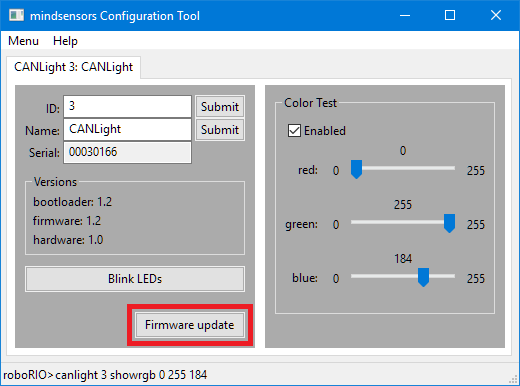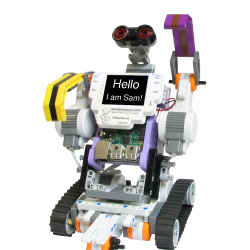CHEAT SHEET For CANLight - LED STRIP Controller Kit for FRC Robots
If you are new to CANLight, please refer to this page for related information, and save this URL for future reference.
Required Software Libraries (for Java & C++)
Download here (for 2018): http://mindsensors.com/largefiles/FIRST/mindsensors2018.zip
Installation of this library:
- Locate 'wpilib' folder on your computer (this is generally here: C:/Users/username/wpilib)
('username' is folder for the user that is logged in.) - Open folder 'wpilib/user',
- Unzip the downloaded zip file,
- This zip has 'user' folder, copy contents of 'user' folder to your wpilib/user folder.
(if there is a conflict with existing files, replace them with newly downloaded files).
mindsensors Configuration Tool
Download here (for 2018): http://www.mindsensors.com/largefiles/FIRST/mindsensorsConfigurationTool.zip
This software can be used to change the ID, name, limit switch settings, invertedness, and stop behavior of an SD540C. It can also be used to update the device's firmware. Read the blog post for details on how to use it.

Key Features
- Control Standard LED Strips
- Input Voltage: 12V DC
- Input Signal: CAN
- Output: R, G, B Voltage for your LED Strip
- Load capacity: 2 amps sustained, 4 amps peak
- Program from roboRIO
- Using LabVIEW, Java, C++
Power Consumption
CANLight itself doesn't take much power to operate, but the LED strip takes 12 volts, the amperage will vary based on the length of your strip.
As a general guideline for most commonly used LED strips, 4 amps are required for every 5 meters, but be sure to refer to the specs of your strip.
CANLight is designed with built in fuse to prevent overload. If you are using the full length of 5 meters of LED strip on your robot, do not light up the LEDs for extended period of time, doing so may cause overload on the device and your battery (and the fuse will be activated).
What is CAN?
CANLight uses CAN protocol to communicate with the roboRIO.
Note: CAN requires a 120 ohm terminating resistor to ensure signal integrity, especially over distances.
See the blog post for detailed information on CAN and network topologies.
ALL Links
Product Pages
SD540C
CANLight
CAN Splitter
CAN Cable
User Guides
SD540C
CANLight
Cheat Sheets
SD540C
CANLight
Documentation
C++
Java
Guides
The Complete Guide on Getting Started with CANLight
CAN and Its Topology
C++/Java Library Installation and Examples
LabVIEW Library Installation and Examples
Full Tutorial on the mindsensors Configuration Tool
All About Limit Switches
CAD Files
SD540C
Files
mindsensors Configuration Tool
mindsensors FRC Library for C++/Java
mindsensors FRC Library for LabVIEW
LabVIEW project with Example VIs
Offline Firmware Update: SD540C .hex File Location
Offline Firmware Update: CANLight .hex File Location
Other Resources
Tutorial on soldering XT60 connectors
FIRST third party support
roboRIO networking
WPILib: Getting Started with the 2017 Control System
Eclipse plugins
Installing Java on roboRIO
Chief Delphi
mindsensors.com forums


